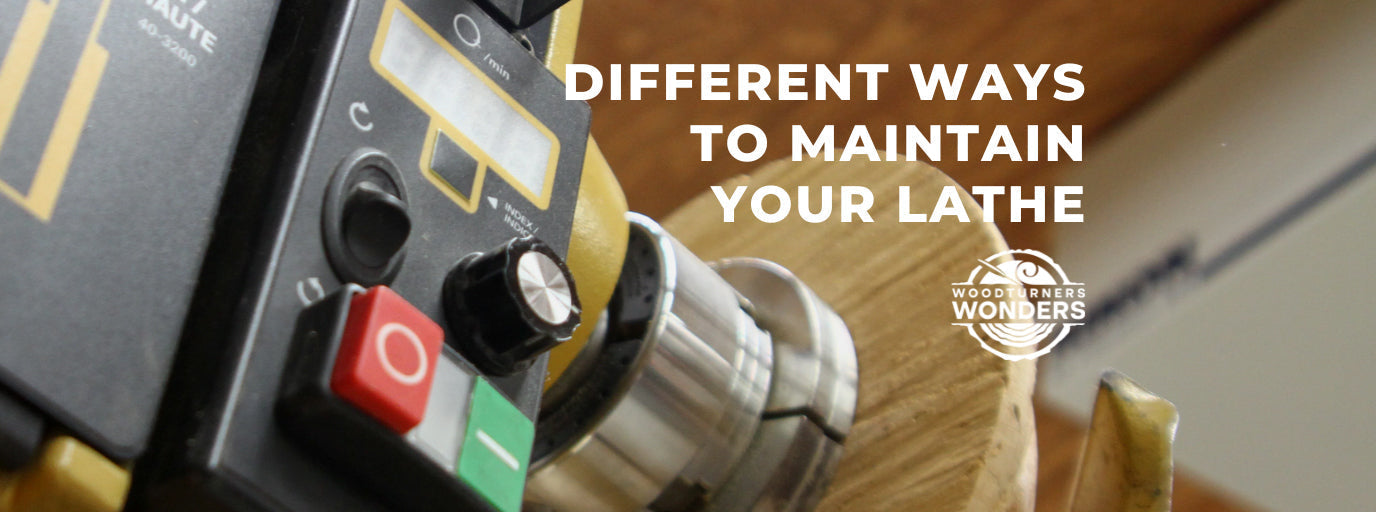
Different Ways To Maintain Your Lathe
Besides guaranteeing that your lathe functions as intended, adhering to the right maintenance procedures means increased safety. Productivity should not come at the cost of safety; always take care of your equipment, and they will take care of you.
Completely Turn Off Your Lathe
The lathe is a heavy piece of equipment with lots of moving parts that can reach speeds of over 1,000 RPM. Therefore, it’s critical to turn the lathe off and unplug it before you attempt any cleaning or maintenance work on it. If you don’t turn everything off, you may inadvertently turn on the lathe, which can damage internal parts—you could even get your hands stuck in moving parts if you aren't careful. Turning it off is vital to your safety.
Inspect The Lathe Bed
Before and after every use of the lathe, you need to make sure to clear away any excess woodchips, dust, and other debris on the lathe bed. Inspect the bed for any signs of rust or deterioration; if the corroding is not significant, you can apply rust remover and clear it away with a steel wool cleaner. Allowing the rust to remain can inhibit the movement of the head and tailstock.
If your lathe bed is far too rusted for safe or practical use, you may have to look into replacing it. This doesn’t require you to replace the entire lathe; the bed can separate from the rest of the machine for quick and safe replacement. Don’t work with a bed that’s rusted beyond acceptable standards; it will only negatively affect your productivity and engage you as you work.
Don’t Neglect The Morse Taper
The morse taper is necessary to mount tooling, but it can easily clog with metal filings and fine dust. It’s necessary to clean out these small crevices to ensure there is nothing blocking it; allowing them to remain clogged with wood dust and other debris significantly reduces reliability.
Neglecting routine cleaning can even damage the mechanism, scratching and scuffing the metal components, potentially resulting in the need for replacements. The damage it sustains can make it difficult—or even impossible in the worst cases—to insert and remove.
Clean Out The Lathe Spindle
The spindle facilitates the rotation of your wooden piece, making it one of the most essential parts of your lathe machine. Because of its importance and the close proximity to the turning and carving, you will expose it to constant debris. Morse taper, wood dust, oil, and debris will gather in the threads.
This excess debris will make it more difficult to insert the chuck into the spindle, and it’ll sit more precariously as you spin your wood. Clean out the debris and clean off any oil to make sure the chuck fits comfortably and that you don’t run the risk of sudden malfunction or reduced efficiency.
Clean Out The Headstock
The pully system inside the headstock can clog with debris, just like the morse taper. It’s necessary to open the access panel to the headstock and clear out any wood shavings and other material with compressed air.
The sensitive components in the headstock can be susceptible to damage if you don’t clean it out. You can damage it if you use the wrong cleaning techniques. When you use compressed air, it blows out any stuck debris without forcing too much pressure on the internal components, keeping everything clean and safe.
Check Out The Drive Belt
The drive belt facilitates the speed and rotation of the spindle; if the drive belt starts to fail, you’ll notice it in the performance of your lathe’s rotation. That makes it critical for turners to routinely inspect their drive belt and ensure there are no cracks forming or any other signs of wear and tear.
Make sure to check both sides of the belt, as damage may appear on one side but won’t necessarily be on the other. Inspect the belt thoroughly and replace it when you notice too much damage; you don’t want it to fail in the middle of a project.
Check The Level Of The Lathe
The lathe should sit level with the ground. Measure it and see that the bed is even with the floor. If the lathe is askew or the floor itself is uneven, adjust the lathe so it stands level.
It isn’t critical for safety to keep it level, but it does make shaving more accurate and increase proficiency with tools. If turners use an unlevel lathe, they’ll pick up bad habits that will hurt their performance when they use a level lathe.
Tighten Any Loose Nuts Or Bolts
The vibration from your turning will inevitably loosen any nuts and bolts in your lathe machine. This constant loosening makes it essential to tighten them up before and after each turning. Make sure you properly fasten them.
Neglecting to tighten them will cause your lathe to be unsecured, exposing you to avoidable danger. To prevent your lathe from vibrating itself to pieces, you need to spend the time to identify all the nuts and bolts and make it a habit to tighten them up whenever necessary.
Take Care Of Your Equipment
The lathe is the most important and expensive piece of equipment you have in your arsenal, so make sure you don’t let it deteriorate. Know the different ways to maintain your lathe woodturning tool to prevent it from serious breakages or inefficient functionality. Protect your tool as well as yourself by maintaining what you have. That way, you can prevent breakdowns and other less-than-ideal outcomes.


Leave a comment